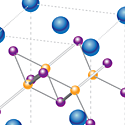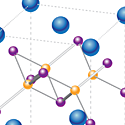The pressure is on to ban doping
In the fast moving field of the iron-arsenide (pnictide) superconductors, the one constant has been that superconductivity only occurs in doped crystals. Being able to “turn on” superconductivity with a different parameter than doping—say with pressure—is attractive because it is possible to explore the properties of the normal and superconducting states in a single crystal, rather than comparing many crystals that have been prepared in slightly different ways.
Writing in Physical Review Letters, Milton Torikachvili of San Diego State University and Sergey Bud’ko and colleagues at Ames Laboratory and Iowa State University show they can induce superconductivity in undoped, single crystals of at low pressures (See also Refs. [1,2]). The group maps out the temperature-pressure phase diagram for , showing superconductivity occurs between roughly 2 and 9 kbar, with a maximum transition temperature of at 5.5 kbar. What is interesting about this region of superconductivity is that two phase transitions—one a low-pressure, structural and magnetic transition, the other, a high-pressure transition that has not yet been identified—appear to vanish where significant superconductivity begins.
Though it is not yet clear if the authors have identified a pressure-induced quantum critical point, this “clean” system will certainly enable a number of important experiments for understanding the properties of these new superconductors. - Jessica Thomas
[1] T. Park et al. J. Phys. Condens. Matter 20, 322204 (2008).
[2] P. Alireza et al. arXiv.0807.1896v1





